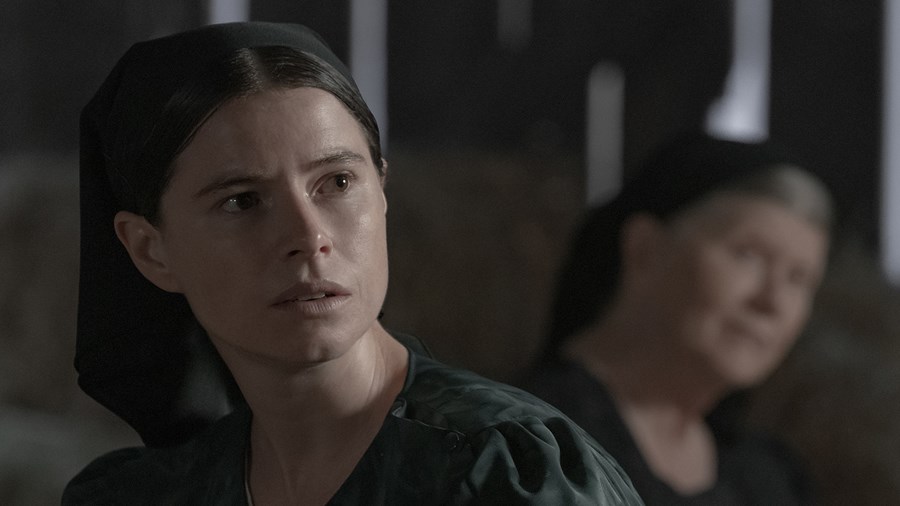By giving voice to women in her discursive drama, Sarah Polley questions cinema’s history of tuning out female speech, argues Lillian Crawford.

At the start of Women Talking, directed by Sarah Polley, on-screen text informs the audience that ‘what follows is an act of female imagination’. The phrase is taken from Miriam Toews’ 2018 novel upon which the film is based. Toews crafts ‘an imagined response to real events’ that took place in the Manitoba Colony of Mennonites in Bolivia between 2005 and 2009, when women awoke to discover they had been raped while unconscious. Their claims of sexual assault were dismissed by the men as ‘wild female imagination’.
Toews’ novel and Polley’s film take this gaslighting phrase and reclaim it. The act of imagination is not, as the men try to convince the women, the idea that they have been raped, but rather the plans and dreams for what a future away from the men will look like. The film depicts a series of meetings in a hayloft between eight women after holding a vote on whether to do nothing, stay and fight the men, or leave to form a new colony. Of course, there is not a singular interpretation – what ensues is discourse and debate that Women Talking identifies as characteristically female. But what exactly does that mean?

Women Talking (2022)
‘History,’ to quote Mrs. Lintott in Alan Bennett’s 2004 play The History Boys, ‘is women following behind with the bucket.’ It is a record of men acting and women picking up the pieces. In cinema, as in history, we predominantly hear men talking. So loud are male voices in the majority of films that in her 1986 comic strip ‘Dykes to Watch Out For’, Alison Bechdel satirised the lack of meaningful female conversation by questioning how many films actually show at least two named women talking about something other than a man. Her quip proved so painfully apposite that it has become a basic metric most screenplays fail to meet.
Following the conceptualisation of this ‘Bechdel Test’, the critical theorist Kaja Silverman wrote The Acoustic Mirror: The Female Voice in Psychoanalysis and Cinema (1988) in which she observes that women in film are consistently shown to be prone to unreliable, hyperbolic gossip. Women’s testimonies are repeatedly depicted as hysterical, and largely the butt of jokes between serious, intelligent men. From Singin’ in the Rain (1952) to Babylon (2022), films show how women’s voices have been mocked as shrill and unpleasant to listen to with the advent of talking pictures, reflecting the real-life phenomenon that ended the careers of many actresses of the silent era.

One work that stands out from classic Hollywood is George Cukor’s The Women (1939). With its all-female cast including Norma Shearer, Joan Crawford and Rosalind Russell, the film is unique in its depiction of women holding conversation without the on-screen presence of men. This sometimes leads to anxiety for women, so internalised is the need for men to validate a woman’s voice that several of the characters warn each other not to listen to their girlfriends. Even in Women Talking there is doubt in some of the women that they can be allowed to make decisions on their own, causing many to vote to remain in the colony in spite of the abuses they have suffered at the hands of their husbands.
Just as characters in The Women consider the liberation of divorce and single life, they are also frightened of what freedom from men will lead to. There’s a deep sense of the unknown, of what happens when women only rely on each other. As Agata (Judith Ivey) says in Women Talking, ‘None of us have ever asked the men for anything.’ When she realises their first request might be to leave them, the council laughs. There is a danger and unease to meeting like this, to talking among themselves, but also a scintillating sense of excitement and optimism for what might come next.
As Silverman’s argument shows, the unbalanced power dynamics of discourse between men and women has become embedded within the fabric of cinema itself. Much like the male gaze, of how women on screen are automatically treated as visual fetish objects, there is a male ear at work in cinema that switches off when women begin to speak. So how do we make a cinema that tunes back in? As film theorist Laura Mulvey wrote in her 1975 essay ‘Visual Pleasure and Narrative Cinema’, we must ‘free the look of the camera into its materiality in time and space and the look of the audience into dialectics, passionate detachment’.

Women Talking (2022)
This might involve removing men altogether, which, except for August (Ben Whishaw) – who takes the minutes of the women’s meeting since they cannot read or write – is the set-up of Women Talking. While the film is being released through the Hollywood machine and features a starry cast including Rooney Mara, Jessie Buckley, Claire Foy and Frances McDormand, its detached aesthetic and focus on dialogue aligns it with a more independent, avant-garde tradition of filmmaking. As is the nature of debate, the film is an experiment in ways of hearing, and the results are moving on the most profound level for women who feel unheard.
That is why it is essential that multiple generations of women meet in the hayloft during the course of Women Talking. While in Toews’ novel the discussion is presented through August’s minutes, the film is narrated by 16-year-old Autje (Kate Hallett), passing on the story of what happened to the unborn child of Ona (Rooney Mara). As in her last film, the documentary Stories We Tell (2012) about her investigations into her parents’ lives, Polley is fascinated by discursive inheritance. Polley is creating a cinema that she wants to see, her acts of female imagination, with the hope that it will influence the cinema yet to come.

